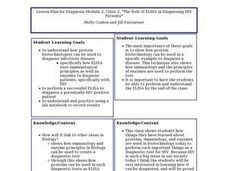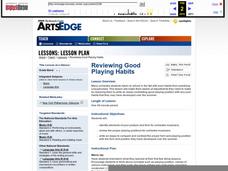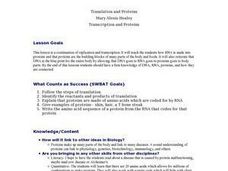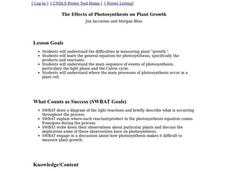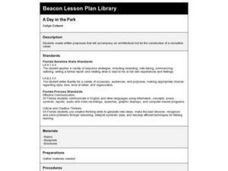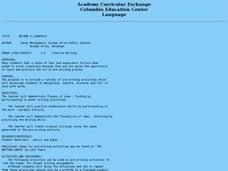Curated OER
Microscopic Water Life
Students use a light microscope to observe the organisms living in a sample of ocean or fresh water. Students create a drawing of the organisms that they observe. Students then discuss the different body plans of the organisms and the...
Curated OER
Antibiotic Resistance
High schoolers conduct an experiment to examine the effects of six different antibiotics on two different types of bacteria. They monitor Petri dishes with bacterial cultures and antibiotic soaked disks. They relate the bacteria growth...
Curated OER
"The Role of ELISA in Diagnosing HIV Patients"
Students explore how proten biotechnologies can be used to diagnose infectious disease specifically how ELISA uses immunological principles as well as enzymes to diagnose patients, and with specifics with HIV. They perform a successful...
Curated OER
Disease Diagnosis
Students comprehend how biotechnology can be used to diagnose infectious disease such as protein technologies vs. DNA technologies. They comprehend procedure and uses of PCR, Western Blot, and ELISA as diagnostic tools. Students know how...
Curated OER
Microbes Are Everywhere - Biology Teaching Thesis
Students are able to list at 3 rules for operating in a laboratory and to explain why each is important. They are able to identify problems with laboratory scenarios presented by the teachers. Students execute a lab protocol using...
Curated OER
Atoms and Elements: An Introduction
Students are able to discuss the difference between a proton, a neutron and an electron. They also can explain the difference between an ionic and a covalent bond. Students know the main structure of atoms and molecules. Student are able...
Curated OER
Drinking Water and Water Purification
Sixth graders design experiments to compare the amount of bacteria in river water to the amount in purified tap water. They explore how water purification removes bacteria and pollution from the water. Students examine the steps of the...
Curated OER
What Does Earth Day Mean? - Biology Teaching Thesis
Students possible sources of water pollution, and explain the effects that water pollution can have on the food on the food chain. They Name human and other animal (i.e. fish) illnesses that can be contracted from drinking polluted...
Curated OER
Reviewing Good Playing Habits
The string section of your school orchestra can get a proper form make-over by incorporating this lesson. They reestablish proper playing form, posture, and sound as they compose an essay on how to maintain good playing habits during...
Curated OER
Parallelism (Unit 7-3200)
How do you create parallel structure? Here, the first section details parallelism, providing many examples. The next two sections provide your class with practice opportunities. The first one requires learners to identify the sentences...
Curated OER
Cell Division
Students describe the cell cycle. They make a connection between DNA replication and cell division. Students describe the parts of the cell that participate in cell division and the steps of cell division.
Curated OER
Vaccines
High schoolers explore and explain the role of vaccines in infectious disease, They emphasize immunological principles and viral/bacterial infection processes. Students explore the three main vaccine types: DNA vaccines ("gene gun"),...
Curated OER
Module #1
Students explore and can explain genetic diseases, and how the central dogma plays a key role in genetic diseases. They comprehend what DNA probe is and how it is created and that there is an ethical component to biotechnology.
Curated OER
Translation and Proteins
High schoolers follow the steps of translation and identify the reactants and products of translation. They able to explain that proteins are made of amino acids which are coded for by RNA. Students are able to give examples of...
Curated OER
An Introduction to Microbes - Biology Teaching Thesis
Students are able to define microbes and identify the five main groups of microbes. They are able to give examples of ways in which microbes have impacted or currently impact human life. Students are able to explain that not all microbes...
Curated OER
The Effects of Photosynthesis on Plant Growth
High schoolers are able to draw a diagram of the light reactions and briefly describe what is occurring throughout the process. They are able to explain where each reactant/product in the photosynthesis equation comes from/goes during...
Curated OER
Color My World
Fourth graders write poems using color to describe their feelings and environment. After viewing a sample student poem imbedded in this plan, 4th graders utilize The Student Writing Center educational software program to type their poem.
Curated OER
A Day in the Park
Fourth graders brainstorm a list of criteria for a quality recreation center. They draft a written proposal the center they plan to design. They write to persuade a land developer to hire their company.
Curated OER
Vocabulary Building - Brainstorming
Students learn new vocabulary words in ways that are fun and enriching. They brainstorm lists of words to be used in sentences, stories, or conversations.
Curated OER
Touring My County
Second graders research important events that occurred in their counties for each year they have been alive. They, in groups, categorize these events and develop notes to be used in the writing of an autobiography.
Curated OER
Rocking the Boat
Students work together to discover the concepts of stability and equilibrium. They examine how equilibrium is related to an item's center of mass. They create their own action scene in a literacy activity.
Curated OER
Magazine Sales Talks
Students role-play to determine the best types of magazines that should be purchased for their media center. They create a sales presentation for a particular magazine in small groups. As they listen to each presentation they evaluate...
Curated OER
Cemetery Art And Architecture Detectives
Students investigate the architecture found in cemeteries in order to separate different time periods of distinct design. The use of examples helps them to recognize the design in correlation to its time. The instructional activity is...




